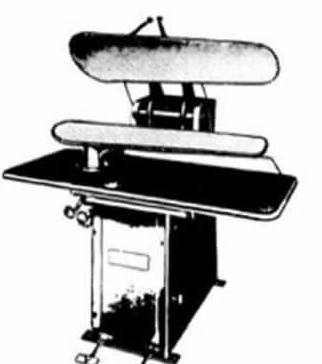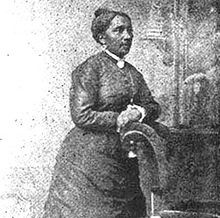The story of Thomas Jennings, the first black person to hold a patent, make money from his invention to free his family from slavery.
Thomas Jennings (1791-12 / 2/1856), an African-American born in New York was one of the leaders in the movement to abolish slavery, building his fortune with the invention of the dry cleaning method. Jennings was only 30 when he received a patent in March 1821 (US code 3306x), and also became the first black person to own a patent for his invention.

Thomas Jennings (1791-12 / 2/1856)
Story
Jennings was born in 1791 in New York City. He became a seamstress and gradually opened one of the top clothing stores in New York, during which time he received a lot of complaints about their clothes always getting dirty - precisely because The material at that time was difficult to remove from the dirt by conventional methods, Jennings began researching a cleaning mixture.
Invented dry cleaning
Thomas experimented with various cleaning compounds on fabrics until the mix reached a suitable ratio. He called it "dry scouring," a process that is now renamed dry cleaning.

The machine for dry cleaning.
He filed in 1820 and was granted a patent for "dry scrubbing" (the patent was burnt during storage). Even so, this method of using solvents to wash out clothes is well known and widely used.
Thanks to the first money earned through this patent, Jennings "bought" his family, freeing them from slavery - including his wife Elizabeth and children (abolished by the 1799 law of In New York, she was transformed into a state of a servant and was not eligible for complete liberation until 1827). Later, most of his income was devoted to abolition of slaves. In 1831, Jennings became the assistant secretary for the first Annual Conference for Colored People in Philadelphia.
Legal issue
Luckily for Jennings, he received a patent at the right time. US patent law from 1793 to 1836, both slaves and ordinary citizens can file for their invention. But in 1857, a slave owner named Oscar Stuart signed up for "a double beard", which was an invention of a slave named Ned. Stuart said that "it is the slave owner who inherits the fruits of the slave, both labor and intellect".
In 1858, the US patent office changed its rules in response to the Supreme Court's case concerning Stuart's patent, Oscar Stuart v. Ned. The court ruled that Stuart was not a citizen and could not be granted a patent. But surprisingly, in 1861, the United States passed a law that granted slavery, and in 1870 passed a patent law that granted all American men including blacks the right to their inventions.
The last years of life
Jennings' daughter, with the same name as her mother - Elizabeth - is an activist like him, a plaintiff in a historic lawsuit after being thrown out of a tram in New York City while on her way home. worship. With help from her father, Elizabeth sued the Third Avenue Railway Company for discrimination and won the case in 1855. One day after the settlement, the company had to order the cars of I have canceled the color separation. After the incident, Elizabeth continued to organize an anti-racist movement in public transport in the city; Capital services are provided by private companies.
At the same time, Thomas was one of the founders of the Legal Rights Association, a group that organizes challenges to discrimination and discrimination and has a legal representative to bring lawsuits out. court. Jennings died in 1856, only a few years before the custom he had fought - the slave - was abolished.

Elizabeth Jennings Graham, a black activist, daughter of Thomas Jennings.
Heritage
Thomas and his daughter attempted to break down racial segregation in public infrastructure, a movement that lasted until the civil rights era a century later. Indeed, the 1963 "I have a dream" speech by Dr. Martin Luther King Jr, in Washington, repeated the accusations that the Jennings family expressed and fought a hundred years ago.
Not only thanks to the invention of the "dry cleaning" method but still widely used to this day, Jennings has created the first steps in the movement to abolish people of black color from the yoke of division. racial discrimination.
According to thoughtco.com
You should read it
- Collection of more than 90 black wallpapers for computers and laptops
- Top 6 largest bird species in the world
- Samsung costs more money for Nokia's patent
- Apple received a patent for flexural screen
- 10 interesting facts about black holes in the universe (Part 1)
- Discover the most bizarre black holes in the mysterious space universe
- The patent shows that iMessage can edit messages sent in the future
- Microsoft requires Samsung to pay additional patents
May be interested
- How to make money, fast heart in Adorable Home
 to plow the real house in adorable home, you will need to spend a lot of time if you do not hold in your hands quick tips for finding. in this article, software tips will guide you how to make money and find the fastest way in adorable home.
to plow the real house in adorable home, you will need to spend a lot of time if you do not hold in your hands quick tips for finding. in this article, software tips will guide you how to make money and find the fastest way in adorable home. - The best 'money-making' apps on Android
 when using a phone, you often think about spending money rather than making money. it usually costs users a small amount of money from prepaid or monthly payments. thankfully, there are many applications in google play that help you offset some of those costs. here are some android apps that help you make money.
when using a phone, you often think about spending money rather than making money. it usually costs users a small amount of money from prepaid or monthly payments. thankfully, there are many applications in google play that help you offset some of those costs. here are some android apps that help you make money. - Revealing Apple's latest invention: The keyboard is made of glass and can be bent
 recently, apple insider has discovered a new patent of the world's largest technology company, showing a glass keyboard and feedback (as described) quite well.
recently, apple insider has discovered a new patent of the world's largest technology company, showing a glass keyboard and feedback (as described) quite well. - How to make money from YouTube Partner?
 making money online now has a multitude of forms including orthodoxy and variation. of course, every way earns money but no effect is the same and it is up to each individual to apply that method. many people who start making money online will be overwhelmed with so many forms that they do not know where to start. today, tipsmake.com would like to guide you to make money by becoming a youtube partner.
making money online now has a multitude of forms including orthodoxy and variation. of course, every way earns money but no effect is the same and it is up to each individual to apply that method. many people who start making money online will be overwhelmed with so many forms that they do not know where to start. today, tipsmake.com would like to guide you to make money by becoming a youtube partner. - Discovered that the 2500-year-old skeleton of the Etruscan civilization suffers from strange chains and legs
 scientists have discovered another dark side of the etruscan civilization through a barbaric, strange skeleton.
scientists have discovered another dark side of the etruscan civilization through a barbaric, strange skeleton. - New Facebook invention allows children to join this social network?
 facebook is currently designing a system that allows children under the age of 13 to be supervised by their parents, under a new patent, complying with the us children's online privacy protection act (coppa ), which does not specify whether children under 13 years of age are prohibited from using online services to collect data without parental permission.
facebook is currently designing a system that allows children under the age of 13 to be supervised by their parents, under a new patent, complying with the us children's online privacy protection act (coppa ), which does not specify whether children under 13 years of age are prohibited from using online services to collect data without parental permission. - How to use Money in Excel, a free and secure money management tool
 do you always ask yourself what you have spent, but the month has run out of money? or what to spend this month, how much is left over? or how much money do we spend on one card, and how much money does the other card have? understanding that, microsoft 365 launched money in excel, helping users manage spending from free and secure account cards.
do you always ask yourself what you have spent, but the month has run out of money? or what to spend this month, how much is left over? or how much money do we spend on one card, and how much money does the other card have? understanding that, microsoft 365 launched money in excel, helping users manage spending from free and secure account cards. - Oil-free fryer - Collection of 50+ delicious recipes easy to make
 thanks to the advantages of fast, convenient and easy to use, the oil-free fryers are often selected by housewives to prepare many delicious delicacies for the whole family. here is a list of over 50 recipes and dishes that you can create with an oil-free fryer. refer to enriching the family's meal.
thanks to the advantages of fast, convenient and easy to use, the oil-free fryers are often selected by housewives to prepare many delicious delicacies for the whole family. here is a list of over 50 recipes and dishes that you can create with an oil-free fryer. refer to enriching the family's meal. - Top 30 sites will pay for the things you did
 let's tipsmake.com find out the top 30 sites that will pay for the things you did in this article!
let's tipsmake.com find out the top 30 sites that will pay for the things you did in this article! - 13 best online money websites today
 please refer to the 13 best websites below that you can use to make more money in the current technological age!
please refer to the 13 best websites below that you can use to make more money in the current technological age!










 Why are Japanese mobile phone companies only able to develop in the domestic market?
Why are Japanese mobile phone companies only able to develop in the domestic market? Vast variety of cages capturing ancient Chinese crickets: The wonderful artifacts of mankind
Vast variety of cages capturing ancient Chinese crickets: The wonderful artifacts of mankind Archaeologist sculpted the face of real people thousands of years ago, 'every millimeter beautiful' made many people cheated
Archaeologist sculpted the face of real people thousands of years ago, 'every millimeter beautiful' made many people cheated Why do so many medieval Europeans sleep in box beds?
Why do so many medieval Europeans sleep in box beds? After deciphering the 800-year-old code and translating an ancient book, the team uncovered the mystery of the Maya civilization
After deciphering the 800-year-old code and translating an ancient book, the team uncovered the mystery of the Maya civilization List of notorious billion-dollar robbery missions in modern times, from ancient ways like Earth to sophisticated psychological tricks
List of notorious billion-dollar robbery missions in modern times, from ancient ways like Earth to sophisticated psychological tricks